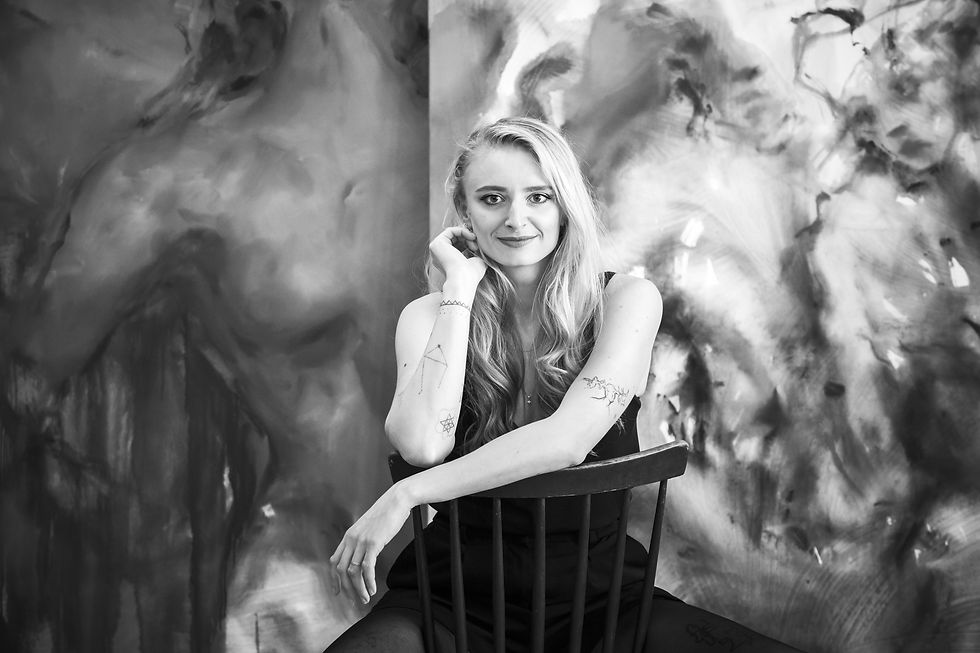AS IS | Markéta Kolářová
- katcintulova
- Jul 27, 2022
- 4 min read
Updated: Aug 19, 2022
Artist
From Polička, Pardubice region, Czechia
Based in Prague, Czechia
Markéta Kolářová paints canvases inspired by mythology, the mysterious and fantastical. Their foundation is abstract and is created intuitively; following this, the artist extracts specific motifs, giving her paintings a face and finalising her creative process

A: Please, tell us a bit more about yourself. What brought you to art?
M: I’ve been carrying the urge to create since childhood. In fact, it was perfectly obvious I’d study an art school from day one and I never even considered any other option. I studied illustration in secondary school and then painting at the Academy of Fine Arts, where I took things a little more seriously and began to realize my inner potential. You encounter many different perspectives and approaches at school that you either accept or reject, thus creating your own artist identity. I started to do that only once I’ve finished school. It helped that I started looking at things through my own eyes only, standing by my decisions, and believing in myself.
A: What inspires you the most?
M: I am certainly inspired by mythology and the female body. Interpersonal relations and fantasy pop culture tend to sneak into my paintings, too. At the same time, the process of painting itself is a significant element as it always surprises me again. I like to work with the so-called “intentional coincidence”, where I begin painting intuitively and expressively on the floor of my studio and then seek and extract individual motifs from the result. Thanks to this approach I discover new possibilities that help me and my work grow.
A: Do you have any specific rituals while working (creating)?
M: You could say that the process of painting itself is a ritual that consists of individual steps. The first one is the spontaneous creation of the underpainting with a certain dynamic intensity as I mentioned above. The second one is observation as even an expected outcome can transform thanks to the paints drying and adding new possibilities. And finally, realising the shapes of the final motifs that give the whole process the magical thrill of expectation.
A: What would you recommend to someone new to art (an artist or just an admirer)? What to begin with?
M: It’s definitely good to go to museums and galleries, visit exhibitions, and keep up with the contemporary art scene. You don’t build this knowledge right away, it comes with time. For example, by attending an opening or a guided tour, you’ll learn more about the works and meet the artist. Personal contact is always better than viewing things from the distance of Instagram. Instagram rarely does the artworks any justice.
A: Your top 3 words or phrases related to art?
M: Feeling, idea, and execution are the subject matters I am after when talking about my work or when I’m learning about the works of others. From that come some more words, maybe phrases, that I may not be aware of. I try to talk about art the same way it originates; spontaneously, to immerse the audience in the experiences and feelings surrounding the process of creation as well as possible.

A: Your favorite Czech artists?
M: I think Jan Preisler’s work was the most essential for me. The atmosphere of his paintings and the figure intersecting the landscape. I appreciate the fantasy and demonicity in Josef Váchal’s work. Or Adriena Šimotová’s delicacy and introspection. I could think of many more.
A: What piece of art do you think embodies the Czech national spirit and culture?Why?
M: I don’t have a simple answer to this question. I am sensitive to the period of the second half of the 20th century and process the communist regime as a time when the most powerful works were created. The deepest urge to process one’s own existence and escape the every-day life. Works that deal with transformation, growth, or disintegration. Often using artists’ own bodies or unstable materials.
A: How do you like to connect with others through art?
M: Thanks to our amazing community at our studio in Libeň, Prague, the conversation is very relaxed and friendly and usually begins with “How’s it going?” Talking to gallerists, curators, or strangers is different; it’s best to introduce your work briefly and accurately, without any unnecessary detours. Connecting with people who run in the art circles is easiest at events such as openings, guided tours, open-door days at studios, final nights, etc.
A: Where can we meet you?
M: You can meet me most often in my studio in Libeň. It’s located above the Libeň train station and the complex houses studios of almost 30 artists. They’re mostly young contemporary artists. I recommend visiting @lieben_artcontemporary on Instagram and checking out the profiles of individual artists. We’re open to getting in touch and welcoming you in our studios.
A: Is there any quote or idea that has guided you in your work and/or life?
M: “Inspiration comes after twilight” comes to mind. It relates to my being a night painter as I prefer working when everything around quiets down and I am able to fully focus on my paintings.
Thank you!
#art #artist #interview #Czechia #travel #arttourism #contemporaryart #artmagazine #personality #profile




Comments